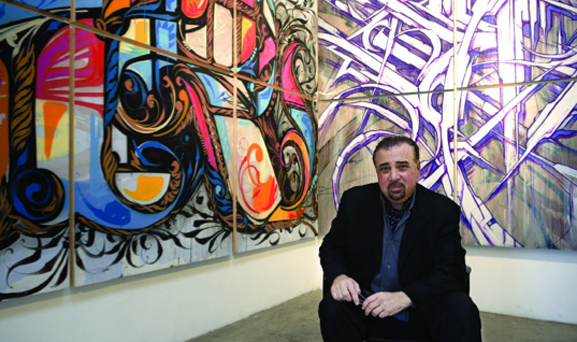A Winning Bid
“Mycrazydriven-nessmakesmeanoutsider in the art world,“ he says modestly.
That “driven-ness” has led him to some bold experiments in selling art. At earlier points in his career, he has auctioned art in a bar, liquidated the collections of failed S&Ls and sold some surprising pieces, including Frank Gehry’s “alligator” installa- tions from the former Rebecca’s restaurant space. A recent exhibition at Robert Berman Gallery was kicked off with a raucous reception, unlike the usual white-wine-and-polite-conversation open- ings typical of most Westside galleries. The show, WILL RISE, featured a floor-to-ceiling installation by the Seventh Letter (T7L)—a gritty, urban graffiti posse—that attracted a crowd of thousands (including a large contingent of tattooed hard cases who were friends of the artists) to watch T7L members Rime, Saber, Pusher, Revok, Zeser, Retna, Reyes, Push, Skrew, Krush and Ewok exe- cute a mural on-site. It was the kind of energetic collision between classes and cultures, street art and fine art that Robert Berman thrives on.
It is with a similar free-wheeling spirit that Berman created Santa Monica Auctions, his comprehensive all-access art sale,slated to occur June 1st of this year at Bergamot Station. It will feature hundreds of works in various media: paintings, sculpture, photography and prints—works that have little in common except quality. “We get etchings by Picasso, and modern masterworks. We always have a lot of Rauschenberg, and we try to get as much Warhol as possible,” says Berman of his annual event.“We try not to have pieces that are too commercial.We will sell things from comparatively unknown or forgotten artists, mixed in with Lichtensteins.”The auction attracts thousands of bidders who show up in person beneath the tent in the Bergamot parking lot as well as individuals from around the world who bid by phone and online. It’s an unpredictable, festive and mildly chaotic celebration of art.
That’s Berman’s intention. “It’s much more democratic than the usual ways of selling art— making private, backroom deals,” the veteran gallerist asserts.“This way, it’s public; anyone can buy, anyone can sell. It’s very people-oriented.”
“I love the idea of anyone being able to buy art,” Berman continues. He is scornful and dismissive of the“artificialelitism”that he feels infects too much of the art world. “Here, you can come in your jeans and buy art you love.”
It is all a part of his“driven-ness”:the need for intellectual and aesthetic experience, and the ambition to be a part of and to help propel one of the most dynamic art markets in the world.That he has chosen to do so in an inventive and unconventional way is typical of Robert Berman, who cannot resist shaking up a milieu he finds occasionally too staid for its own good.The Santa Monica Auctions are part of that campaign.
“It’s a performance,” the gallerist admits. “It’s an act of civil disobedience—everyone in the art world is so uptight.”


